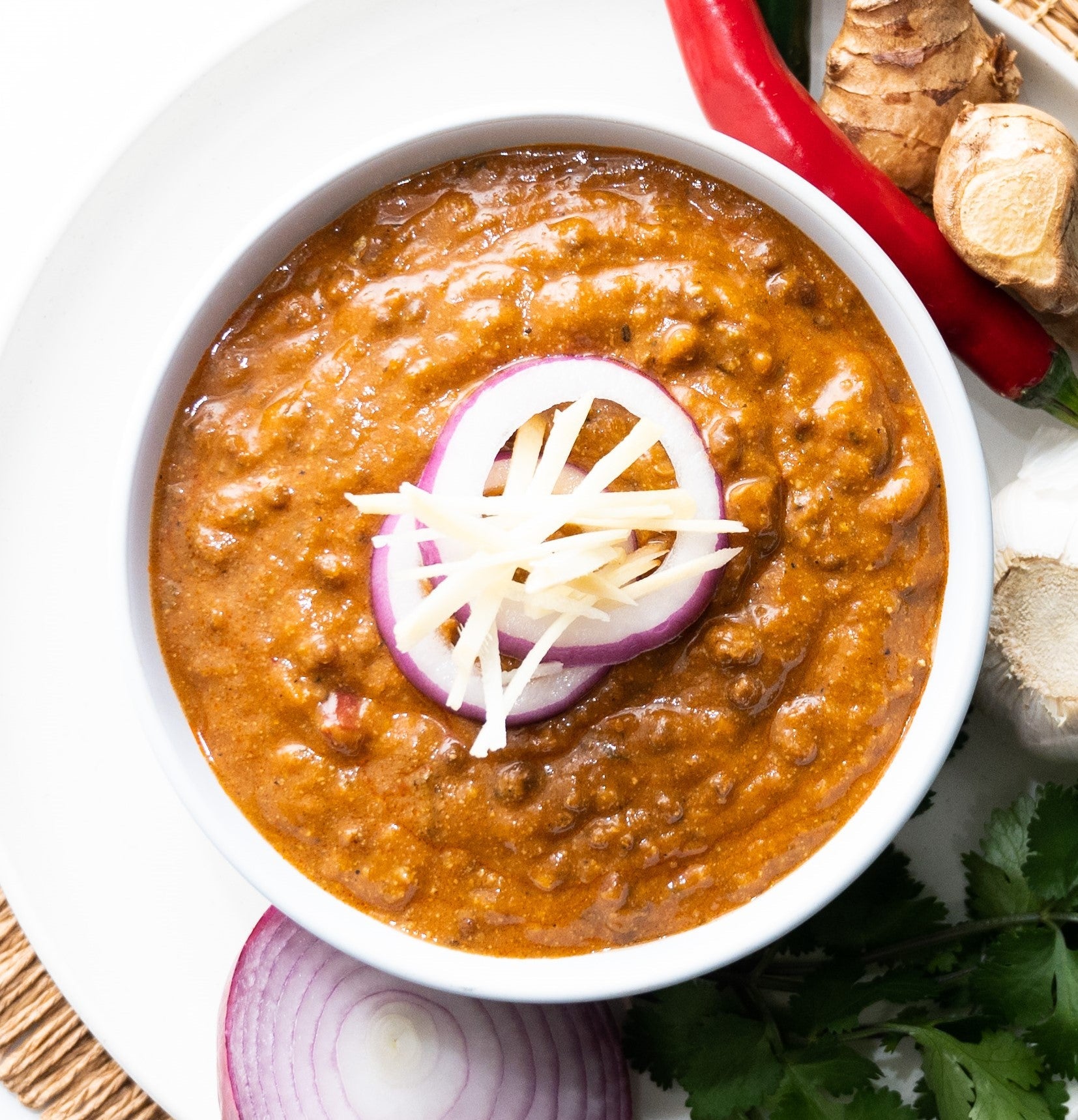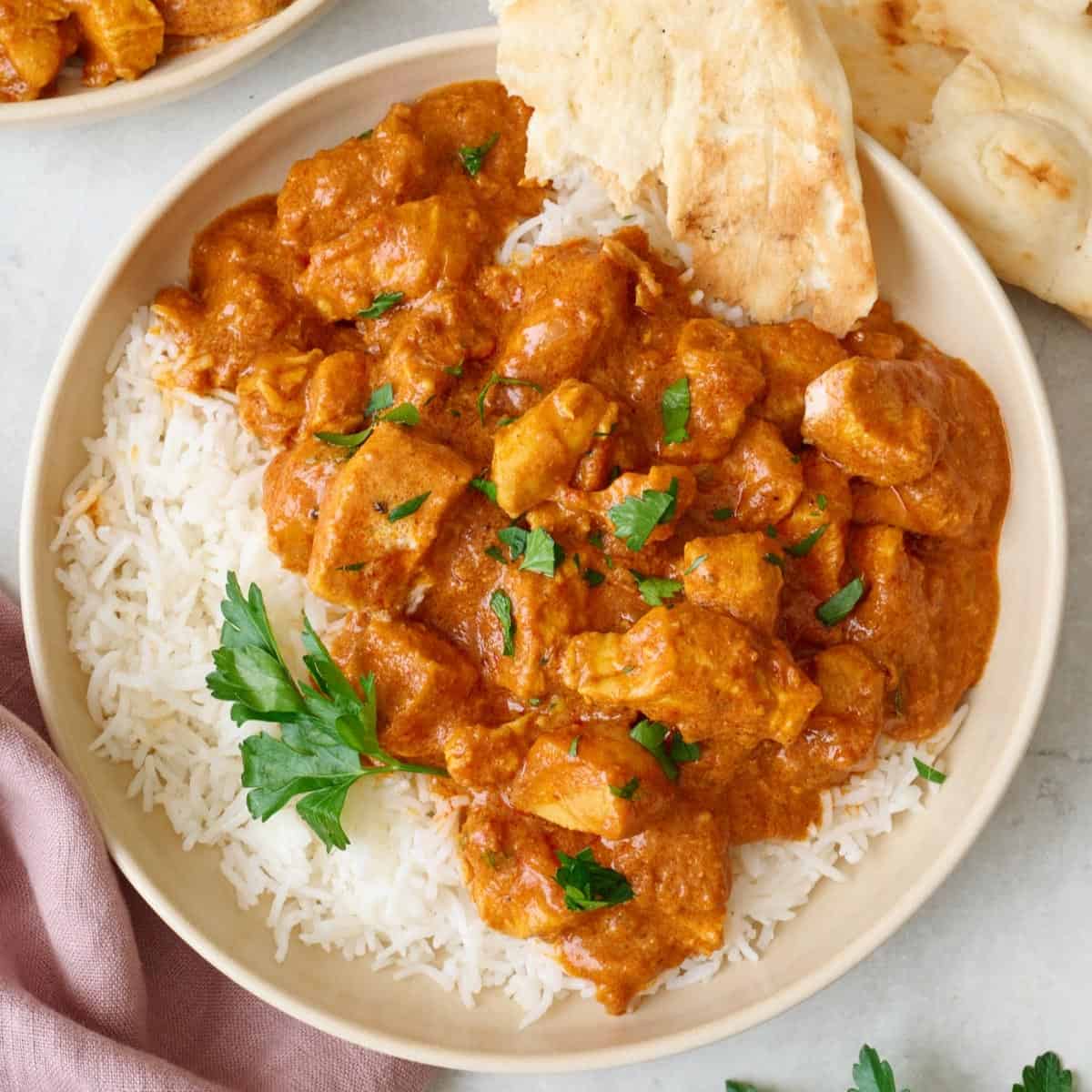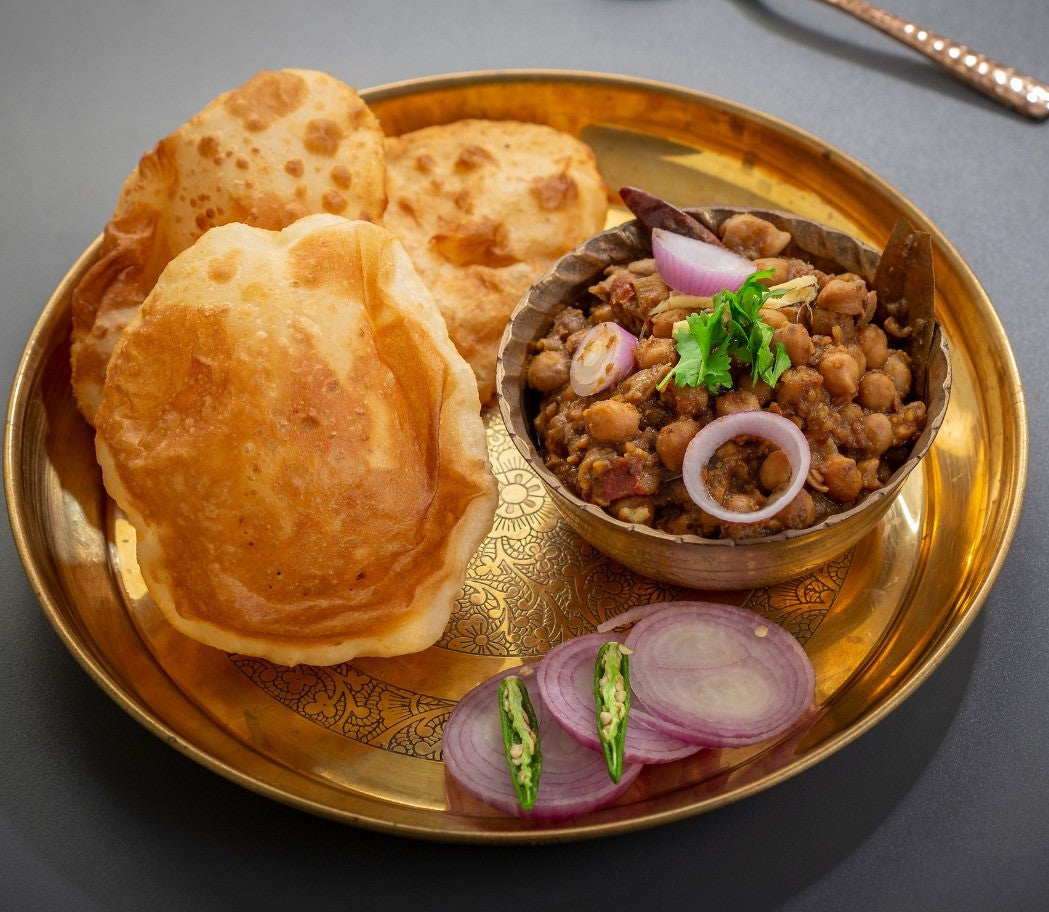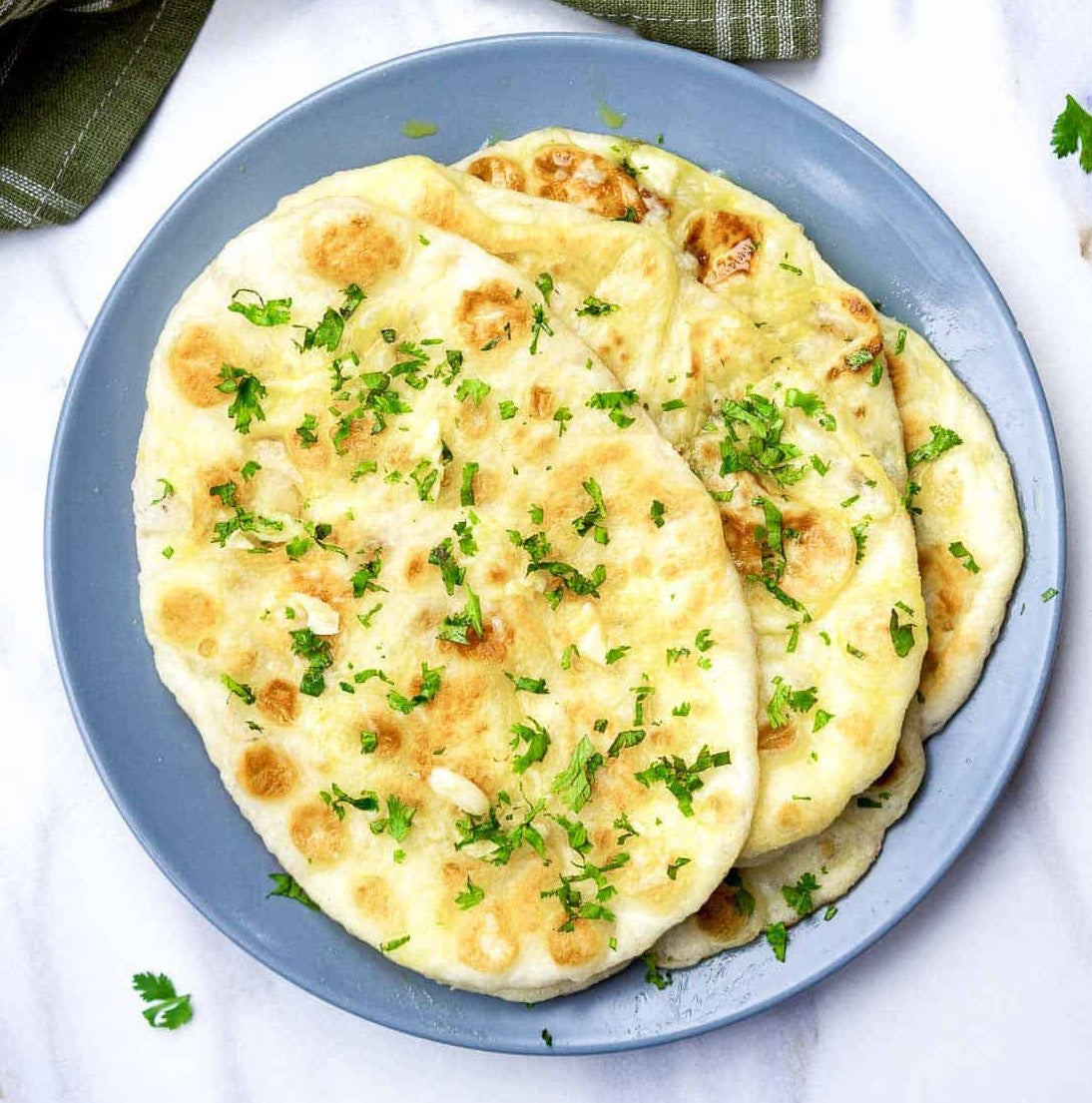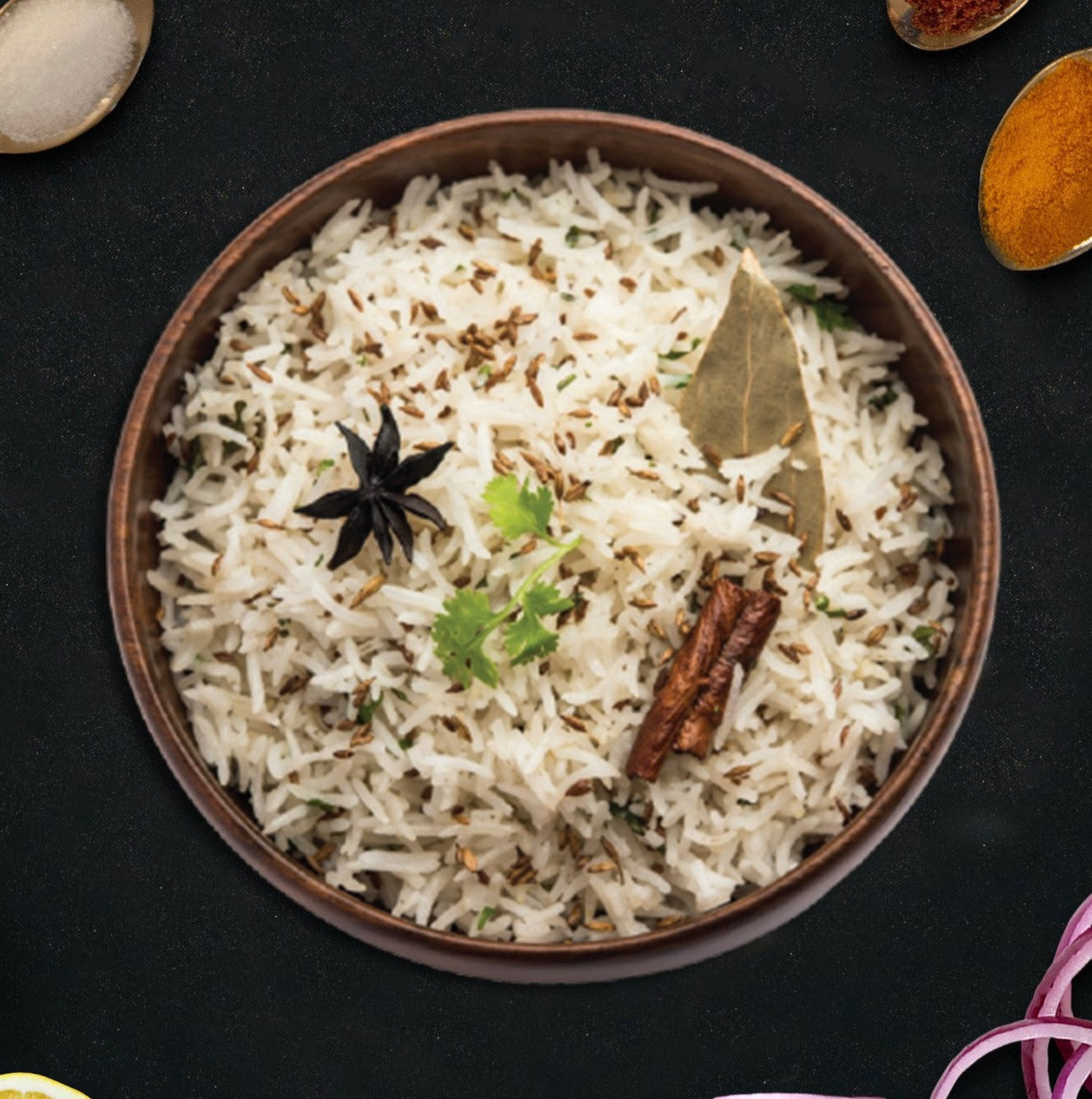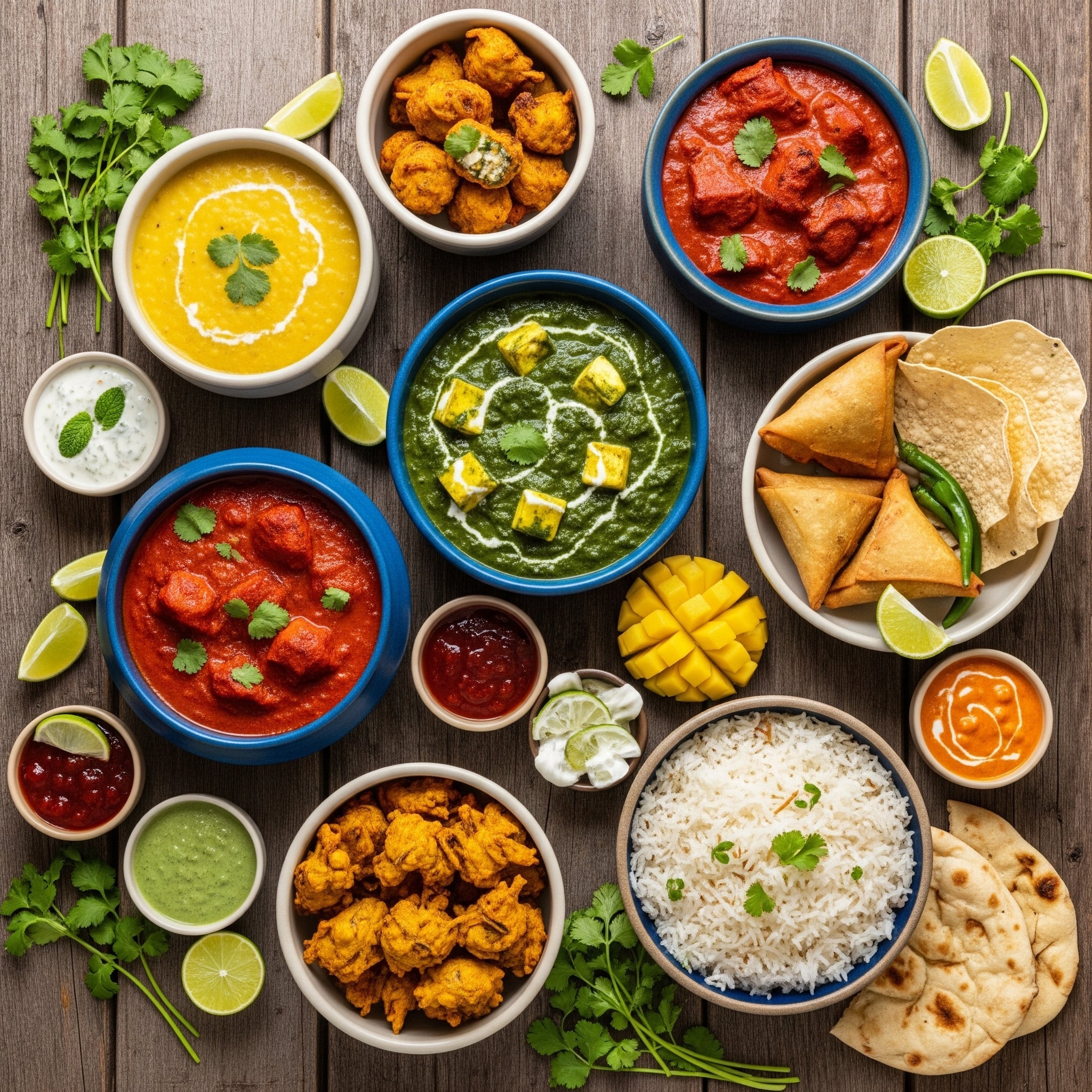
indian spices near me: Top Local Shops & Picks
Finding authentic Indian spices near me isn't as hard as you might think. From dedicated local grocers to the surprisingly well-stocked aisles of major supermarkets, vibrant Indian flavours are closer than ever. In places like Harris Park in Sydney or Dandenong in Melbourne, you can find an incredible, immersive experience, but even the big chains offer easy access to the essentials.
Where to Find Authentic Indian Spices Locally
The hunt for genuine Indian spices can feel a bit overwhelming at first, but aromatic, high-quality ingredients are often just around the corner. If you move beyond a quick online search, you’ll discover a world of flavour, whether you're a pro in the kitchen or just starting out.
You've really got two main options: dedicated Indian grocery stores and the international food sections of the big supermarkets.
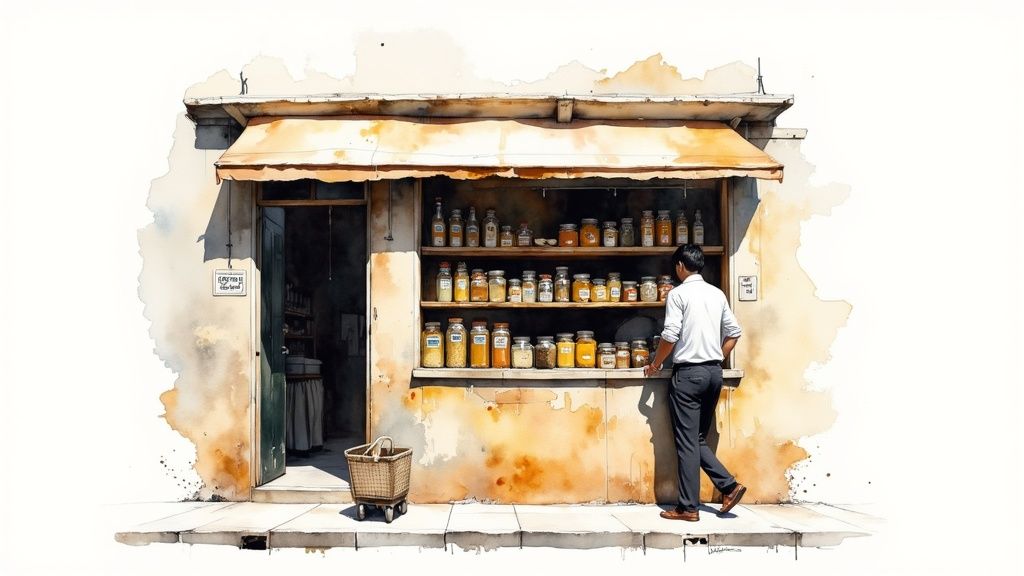
Each has its own perks. The local Indian grocer gives you an unbeatable variety and a truly authentic vibe. On the other hand, the supermarket offers pure convenience for grabbing the basics while you do your weekly shop.
To help you decide where to start, here's a quick breakdown.
Your Quick Guide to Finding Indian Spices Locally
This table summarises what you can expect from each type of store, helping you figure out the best place to go based on what you need.
| Store Type | What to Expect | Best For |
|---|---|---|
| Indian Grocery Stores | An incredible variety of whole and ground spices, regional blends, bulk sizes, and fresh ingredients like curry leaves. | Authenticity, hard-to-find items, bulk buying, and getting advice from knowledgeable staff. |
| Large Supermarkets | A curated selection of essential spices like turmeric, cumin, and garam masala from well-known brands. | Convenience, topping up on pantry staples, and finding beginner-friendly spice kits. |
| Asian Grocers | A broad range of spices that overlap with Indian cuisine, plus other South Asian ingredients. | Finding substitutes and exploring ingredients used across different Asian culinary traditions. |
| Online Specialty Stores | A massive, curated selection delivered to your door. Freshly ground spices are often a highlight. | Specificity, sourcing premium or organic spices, and the convenience of home delivery. |
Ultimately, a combination of these options will give you the best of both worlds: the convenience of the supermarket for everyday needs and the amazing variety of a specialty grocer for when you're cooking something special.
The Indian Grocery Store Experience
For the most authentic stuff, nothing beats a trip to a dedicated Indian grocer. These shops are absolute treasure troves, usually tucked away in vibrant community hubs. The moment you walk in, you’re hit with the incredible aroma of spices, incense, and maybe even some freshly made sweets.
Here’s what makes them so great:
- Unmatched Variety: You’ll find everything from whole spices and freshly ground powders to unique regional blends and ingredients you just won’t see elsewhere, like black salt (kala namak) or asafoetida (hing).
- Bulk Buying Options: Need a lot of turmeric or cumin? You can buy larger quantities here for a fraction of what you’d pay at a big supermarket.
- Expert Advice: The owners are often fantastic cooks themselves. Don't be shy—ask them for tips on which spice to use for a specific curry. It’s invaluable advice.
This kind of immersive shopping experience doesn't just get you the ingredients; it connects you to the culture behind the food. If you're looking for ideas on what to cook, you might like our guide on finding authentic Indian food.
Supermarkets and Their International Aisles
Don't write off your local Coles or Woolworths just yet. As demand for global flavours has exploded, their international food sections have gotten seriously good. In fact, the Australian herbs and spices market is expected to hit nearly USD 7 billion by 2035, which shows just how much we've come to love cooking with these ingredients.
In the international aisle, you can almost always find the foundational spices—think turmeric, cumin seeds, coriander powder, and garam masala. The range won’t be as vast as a specialty store, but it’s absolutely perfect for beginners or for those times when you just need a quick pantry top-up.
Your First Trip to an Indian Grocery Store
Walking into a proper Indian grocery store for the first time is a full-on sensory experience. The air is thick with the smell of cardamom, cumin, and maybe even some incense. You'll see aisles packed with a vibrant tapestry of colours and textures. It can feel a bit overwhelming, but I promise, with a few pointers, you'll be navigating it like a pro in no time.
Most stores have a similar flow. You’ll usually find fresh produce like curry leaves, green chillies, and coriander near the front. After that, you'll hit the aisles for lentils (dals) and beans, then a huge variety of flours (attas), and finally, the main event—the spices.
Decoding the Spice Aisle
This is where the real magic happens. When you’re looking for Indian spices near you, you'll find them in two main forms: whole and ground. While pre-ground powders are super convenient, buying whole spices is a total game-changer for flavour.
Whole spices hold onto their essential oils for much longer. When you toast them for just a minute in a dry pan before grinding, they release an incredible depth of aroma that you just can't get from a pre-packaged powder.
- Whole Spices: Keep an eye out for things like cumin seeds (jeera), coriander seeds (dhania), black mustard seeds (rai), and whole dried chillies. These are the foundation of so many Indian dishes.
- Ground Spices: For everyday staples like turmeric (haldi) and red chilli powder, buying them ground is perfectly fine. They’re great for adding colour and a consistent base flavour to your cooking.
Don't be shy—pick up the packages. A good quality spice will have a strong, pleasant aroma that you can often smell even through the plastic. If it smells dusty or faint, it’s probably been sitting on the shelf for a while.
How to Spot What's Fresh and What's Not
With so many options staring back at you, knowing how to spot quality is key. It's less about the brand name and more about freshness, which makes all the difference in your final dish.
First, look for a packaging date. Any reputable brand will have a 'packed on' or expiry date printed clearly. The more recent, the better. Spices don't really 'spoil', but they lose their punch and flavour over time. As a general rule, ground spices are at their best within six months, while whole spices can last well over a year if you store them right.
A quick visual check can tell you a lot. Vibrant colours are a fantastic sign of freshness. Your turmeric powder should be a bright, golden yellow, not a dull mustardy shade. Likewise, good chilli powder should be a rich, deep red. Faded, dull colours are a red flag for an old or low-quality product.
Finally, trust your sense of smell. If the shopkeeper lets you, or once you get your haul home, open the packet and take a good sniff. The aroma should be pungent and exactly what you expect from that spice. A weak scent means a weak flavour.
Don't Just Stop at the Spices
While spices might be your main mission, don't miss out on the other gems hiding in the aisles. You'll find huge bags of fragrant basmati rice, a dazzling array of lentils, and specialty flours like gram flour (besan), which is perfect for making things like pakoras.
Part of the fun is just exploring these aisles and letting them inspire you to try new recipes. So take your time, be curious, and never hesitate to ask a staff member for a recommendation—they're often an amazing source of insider knowledge.
Building Your First Masala Dabba (Spice Box)
If there's one secret to making Indian cooking feel effortless and joyful, it's not a complex recipe—it's the masala dabba. This traditional stainless steel spice box is the true heart of an Indian kitchen, keeping your most-used spices organised and right at your fingertips. It transforms a frantic search for tiny jars into a graceful, fluid process, making everything from a quick weeknight dal to a weekend feast so much smoother.
Putting together your first masala dabba is a bit of a rite of passage. The idea is to fill the small inner bowls (called katoris) with the seven foundational spices that form the backbone of thousands of Indian dishes. Get these sorted, and you're ready to cook.
The Core Seven Spices
Choosing the first seven spices for your dabba is the fun part. While every family and region has its own preferred lineup, there’s a classic set that gives you incredible versatility. Think of these as your non-negotiables.
- Turmeric Powder (Haldi): That brilliant golden-yellow powder you see everywhere. It brings a warm, earthy flavour and its signature colour to just about every savoury Indian dish. It’s also a well-known anti-inflammatory.
- Cumin Seeds (Jeera): These little seeds are magic. When you drop them into hot oil or ghee, they sizzle and release the most amazing nutty, smoky aroma. This tempering technique, called tadka, is fundamental. You can dive deeper into the world of cumin in Indian cuisine to see just how essential it is.
- Coriander Powder (Dhania): Don't confuse this with the fresh leaves! Made from ground coriander seeds, this powder has a mild, almost citrusy sweetness that adds body and depth to curries and gravies.
- Red Chilli Powder (Lal Mirch): This is where the heat comes from. You'll find different types, from mild Kashmiri chilli (great for colour) to fiery hot varieties. Start with a milder one if you're unsure about your heat tolerance.
- Mustard Seeds (Rai/Sarson): Tiny black or yellow seeds that pack a serious punch. They pop and splutter in hot oil, releasing a sharp, pungent flavour that’s absolutely essential in South Indian cooking and many pickles.
- Asafoetida (Hing): This is a powerful resin with a potent onion-garlic smell that completely transforms once cooked, becoming savoury and mellow. You only need the tiniest pinch to add an incredible umami depth, especially to lentil and bean dishes.
- Garam Masala: This isn’t one spice but a complex, aromatic blend of "warming" spices like cinnamon, cloves, cardamom, and black pepper. It’s almost always added near the end of cooking to preserve its beautiful fragrance.
When you're out shopping, a quick visual and scent check can tell you a lot about the quality of the spices you're buying.
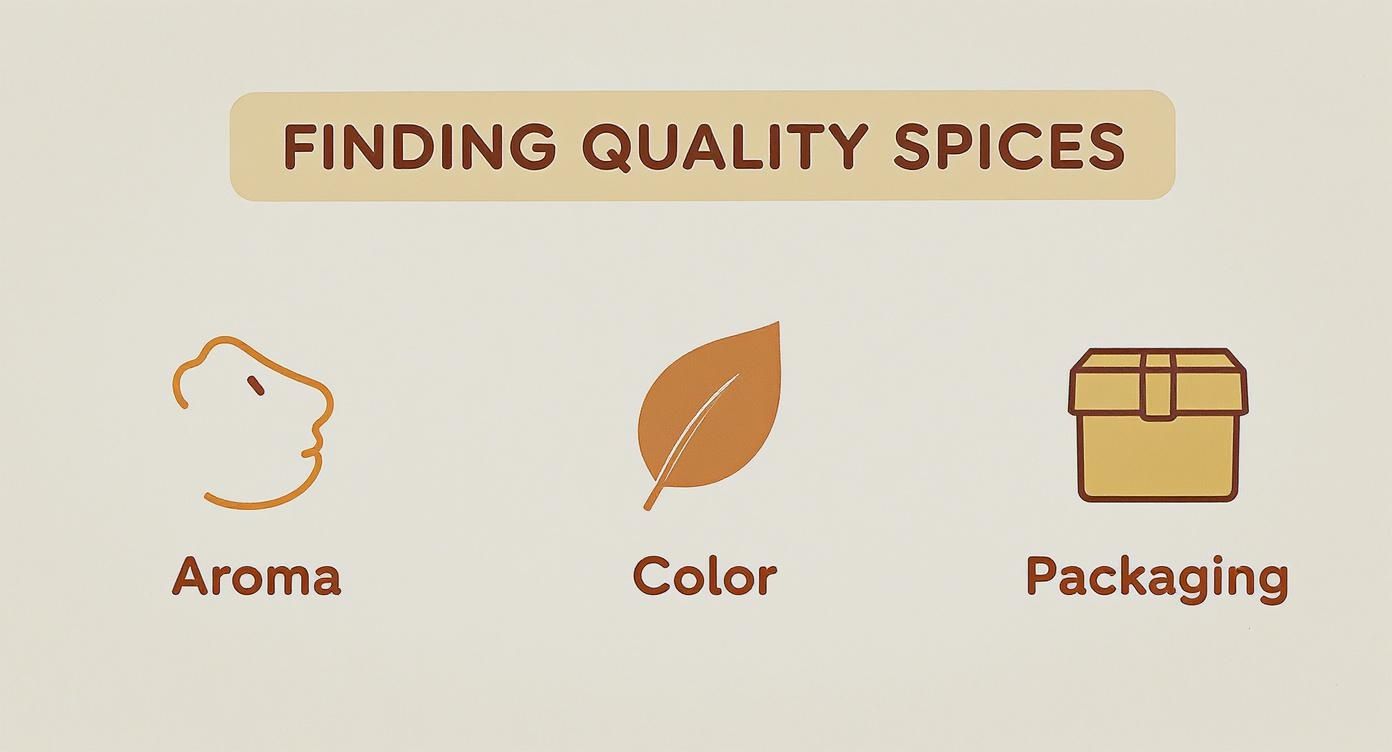
Ultimately, your senses are your best guide. A strong, pleasant aroma, vibrant (not dull) colour, and well-sealed packaging are all signs that you're getting fresh, potent spices that will make your food sing.
Essential Spices English vs Hindi Names
When you're in an Indian grocery store, you might see spices labelled with their Hindi names. This quick reference table will help you know exactly what you're looking for, no matter the language on the packet.
| English Name | Hindi Name | Flavor Profile | Common Use |
|---|---|---|---|
| Turmeric | Haldi | Earthy, slightly bitter, peppery | Curries, dals, rice, marinades |
| Cumin | Jeera | Nutty, warm, smoky | Tadka, spice blends, rice dishes |
| Coriander | Dhania | Mild, citrusy, sweet | Gravy bases, vegetable dishes |
| Red Chilli | Lal Mirch | Pungent, spicy, smoky | Adds heat and colour to most dishes |
| Mustard Seeds | Rai/Sarson | Sharp, pungent, nutty | Tadka (especially South Indian), pickles |
| Asafoetida | Hing | Pungent, savoury, onion-like | Dals, bean curries, vegetable stir-fries |
| Cloves | Laung | Strong, sweet, aromatic | Garam masala, biryanis, meat dishes |
| Cardamom | Elaichi | Sweet, floral, intensely aromatic | Desserts, tea (chai), biryanis |
| Cinnamon | Dalchini | Sweet, woody, warm | Garam masala, rice dishes, desserts |
| Black Pepper | Kali Mirch | Pungent, hot, woody | Nearly all savoury dishes, marinades |
Having this list handy on your phone can save you a lot of confusion and make your shopping trip much more efficient. Happy cooking
Shopping for Indian Spices Online in Australia
Sometimes, a trip to the local Indian grocer just isn't possible. Maybe you’re short on time, or the nearest specialty store is a bit of a trek. This is where online shopping completely changes the game. It opens up a whole world of incredible, high-quality spices delivered right to your doorstep, whether you're in metro Sydney or a quiet regional town.
For anyone juggling a busy schedule, this convenience is a lifesaver. Online retailers often have a direct line to suppliers, which can mean you get spices that are far fresher and more potent than what’s been sitting on a supermarket shelf for months. It’s also your best bet for finding those rare ingredients or unique spice blends that local shops might not carry.
Finding Reputable Online Spice Stores
The secret to a great online experience is knowing who to trust. Not all digital storefronts are the same, so spending a few minutes checking them out is well worth the effort.
So, how do you spot a good one? Start by looking for sellers who are open and honest about what they're selling. Here’s what I look for:
- Detailed Product Descriptions: A good seller won't just list "cumin." They'll tell you about its flavour profile, where it's from, and whether it’s whole or ground. The more detail, the better.
- Clear Sourcing Information: The best online stores are proud of their products and will often tell you exactly where their spices are sourced from. This is a huge sign of quality and freshness.
- Recent Customer Reviews: See what other home cooks are saying. Consistent praise for aroma, flavour, and fast delivery is a pretty reliable sign you've found a winner.
Many online grocers are specialists in Indian ingredients, so you can often find everything you need in one place – from your basic everyday spices to complex masalas and tricky-to-find items like asafoetida or black salt.
The Rise of Organic Indian Spices
More and more Aussies are looking for organic options in their pantries, and spices are no different. In fact, the organic segment of the Indian spices market is growing fast, driven by people who really care about clean, pure ingredients.
This market was valued at USD 584.00 million and is expected to keep growing. You can dive deeper into the Australian organic spices market on IMARC Group.
Online shops have been brilliant at making these organic spices easy for everyone to get. You'll almost always find a much bigger selection of certified organic turmeric, cumin, and coriander online than you would in your average grocery store.
When you're buying organic spices online, always look for the official certification logos on the packaging. This is your guarantee that the product meets Australia's strict organic farming standards, so you can be confident you’re getting a pure, chemical-free product.
At the end of the day, buying your spices online offers an unbeatable mix of convenience and choice. Pick a good supplier, and you can keep your kitchen stocked with the freshest, most aromatic ingredients, ready to bring that authentic flavour to every meal you cook.
Diving Into Pastes, Sauces, and Ready-Made Blends
Let’s be honest, authentic Indian flavour isn’t always built from a dozen individual spices. On those busy weeknights when you’re craving a proper curry but don’t have an hour to spare, the world of pastes, sauces, and ready-made blends is an absolute lifesaver.
These aren't "cheats"; they're smart shortcuts to building deep, complex flavours in a fraction of the time.
A classic example is ginger-garlic paste. It’s a staple in just about every Indian kitchen for good reason—it saves you from the fiddly job of peeling and mincing. Just one spoonful creates that fragrant base essential for so many dishes. The same goes for tamarind concentrate, which gives you that classic sweet-and-sour tang for South Indian curries and chutneys without you having to soak and strain the pulp yourself.
How to Choose a Great Pre-Made Cooking Sauce
Walking down the sauce aisle can feel a bit overwhelming, but grabbing a good jarred sauce is one of the best kitchen hacks out there. You’ll see all the classics like Tikka Masala, Korma, and Vindaloo that can turn some simple chicken or veggies into a showstopper meal in less than 30 minutes.
The trick is to get good at reading the labels.
When you're picking a sauce, flip it over and scan the ingredient list. You want to see brands that use real, whole ingredients like tomatoes, onions, and actual spices. Steer clear of anything packed with artificial flavours, colours, and loads of sugar or salt. A quality sauce should taste fresh and vibrant, not like it came from a factory.
My Favourite Tip: Never treat a jarred sauce as the finished product! It's just a fantastic starting point. You can easily give it a lift by stirring through some fresh coriander, adding a big squeeze of lemon juice, or swirling in a dollop of yoghurt right at the end. It makes all the difference.
It’s no surprise these convenient options are flying off the shelves. The seasonings and sauces market in Australia, which includes all these brilliant Indian blends, has hit a whopping USD 1,746.15 million and is only getting bigger. This just shows how much busy Aussies value being able to cook authentic-tasting meals without the hours of prep. You can dig into the numbers yourself in this research on the Australian seasonings and sauces market.
Don't Forget Spice Blends and Meal Kits
Beyond the wet sauces, keep an eye out for pre-mixed dry spice blends, often called ‘masalas’. A good Biryani Masala or Chana Masala is a game-changer. These are expertly balanced mixes that take all the guesswork out of getting the ratios right, so you get a perfect result every time.
And for those days when you need the ultimate in convenience, ready-to-eat meals offer the whole package. If you’re looking for some top-notch options, have a look at our guide to the best ready meals in Australia that deliver incredible flavour with zero effort.
Keeping Your Spices Fresh and Flavourful

So, you've found a fantastic source for Indian spices near you and brought home a haul of vibrant, aromatic treasures. Brilliant! But the journey doesn't end there. The real secret to incredible Indian cooking is making sure those spices stay as fresh and fragrant as the day you bought them.
Think of your spices as having four natural enemies: heat, light, air, and moisture. Each one is a silent flavour-thief. That convenient spot right next to your stovetop? The constant heat will literally cook the life out of your paprika. And that sunny spot on the windowsill will bleach your turmeric and dull its earthy notes. Air and humidity are just as bad, causing ground spices to lose their punch and turn into sad, clumpy bricks.
The Best Way to Store Your Spices
Your spices need a safe haven—somewhere cool, dark, and dry. A dedicated cupboard or a deep drawer, well away from the heat of the oven and the steam from the sink, is your best bet. While those countertop spice racks can look great, they're often the worst place for your spices unless your kitchen is a showroom that's never actually used.
Airtight containers are non-negotiable. I find glass jars with tight-sealing lids work best because they don't hold onto old smells and you can see what's inside.
Here's a pro tip I always follow: whole spices will always outlast ground ones. If you store them correctly, whole spices like cardamom pods or cinnamon quills can stay potent for up to two years. Ground spices, on the other hand, are best used within six to nine months.
A Quick Freshness Check
Is that jar of garam masala still good? Has your cumin lost its oomph? Don't guess—your own senses are the most reliable tools you have. Here’s a quick test I use all the time.
- Look: What's the colour like? It should be rich and vibrant. If it looks pale, faded, or dusty, it's a bad sign.
- Smell: Open the jar and take a good sniff. A fresh spice will hit you with its distinct, strong aroma. If you get a whole lot of nothing, it's past its prime.
- Taste: Still on the fence? Put a tiny pinch on your tongue. The flavour should be sharp and clear, not weak or stale.
Making these simple habits part of your routine means every curry, dal, or marinade you make will be packed with the incredible flavour you expect.
Got Questions About Buying Indian Spices? Let’s Clear Things Up
Diving into the world of Indian spices for the first time can feel a little overwhelming. You're standing in an aisle, faced with dozens of packets, and a few questions pop into your head. From decoding labels to figuring out what's really essential, getting the right advice makes the whole experience much better.
Let's tackle some of the most common things people ask.
Whole Spices vs. Ground: What’s the Real Difference?
This is probably the biggest question I get. While pre-ground spices are undeniably convenient, whole spices are the undisputed champions of flavour. They keep their precious aromatic oils locked inside, which means you get a much more vibrant, complex taste when you grind them yourself right before cooking.
My personal rule of thumb is this: for spices I use a ton of, like turmeric and chilli powder, I'll grab the ground version for sheer ease. But for everything else, especially aromatic powerhouses like cumin seeds, coriander seeds, and cardamom pods, buying whole is a tiny bit of effort for a massive flavour payoff.
How Can You Tell if Spices Are Fresh?
Another great question. How do you know the packet you’re holding hasn't been sitting on a shelf for a year? First, always look for a 'packed on' or expiry date—that’s your most reliable clue.
After that, it's all about using your senses. Good, fresh spices should have a deep, vibrant colour. If that chilli powder looks dull and brownish instead of a rich red, leave it. A strong, fragrant aroma is the other dead giveaway. If you can barely smell it, it's not going to do much for your food.
Do I Really Need to Buy the Expensive Brands?
Honestly? Not really. When you’re searching for Indian spices near me, you'll see a massive difference in price. A fancy jar in a major supermarket is often more about branding and packaging than what's inside.
I find that dedicated Indian grocers almost always have fresher, more potent spices, often sold in more generous quantities for a much better price. Your focus should always be on freshness, not a fancy label.
Do I Need Every Single Spice a Recipe Calls For?
Absolutely not, especially when you're starting out. While it's incredibly satisfying to build up a well-stocked spice collection over time, you can cook a huge range of incredible Indian dishes with a solid foundation.
Start with a core set of about seven to ten essentials. Think turmeric, cumin (both seeds and powder), coriander powder, and a good garam masala. Once you have those basics down, you can slowly add more interesting spices to your pantry as you get more adventurous with your cooking.
Share

